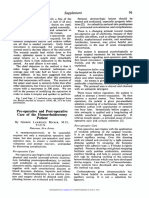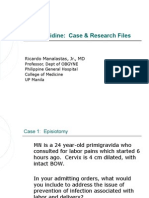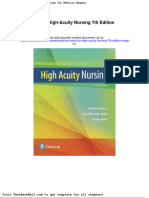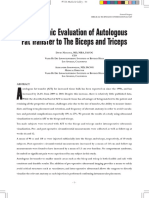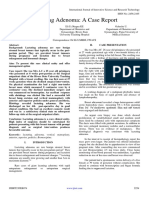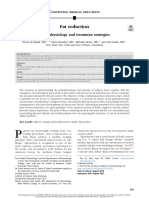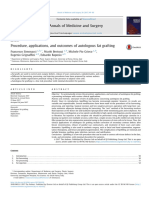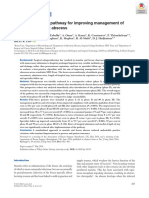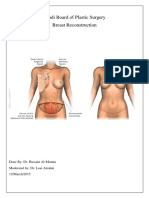Professional Documents
Culture Documents
Breast Abscess After Autologous Fat Transfer
Original Title
Copyright
Share this document
Did you find this document useful?
Is this content inappropriate?
Report this DocumentCopyright:
Breast Abscess After Autologous Fat Transfer
Copyright:
Volume 4, Issue 2, February – 2019 International Journal of Innovative Science and Research Technology
ISSN No:-2456-2165
Breast Abscess after Autologous Fat Transfer
1
Shadi Naasan Alhaj Ali, MD 2Ioan Lascar, MD, Ph.D.
1,2
Carol Davila University of Medicine and Pharmacy, Plastic and Reconstructive Microsurgery Department, Clinical Emergency
Hospital of Bucharest, Romania
Abstract:- Augmentation mammoplasty using complications such as excessive edema, excessive bruises,
autologous fat transfer has been widely practiced. hematoma formation, fat necrosis, infection and abscess
However, this procedure is not exempted from formation, calcifications, oil cysts, shape imbalance, and
complications even after technique refinements. These donor site complications.[3]
complications include excessive bruising, edema,
hematoma formation, infections, fat necrosis, oil cyst Infection and abscess formation are considered the most
formation, and donor site complications. The important complications because it may develop into severe
development of infection and abscess formation deserve septicemia and sepsis with high mortality, as well as the
the most attention. In case of delayed infection, a high infection process kills the grafted fat cells and the results
suspicion of unusual bacteria should be considered. will be disappointing. [3]
Case Presentation: We report the case of a 32-year-old
female patient underwent breast augmentation using In order to achieve successful fat grafting, and reduce
autologous fat graft; the patient demonstrated delayed the rate of complications, the technique used for fat
right sided breast abscess caused by a rare etiology harvesting, processing and insetting is the most important.
identified by culture as peptostreptococcus. This Gentle manipulation of the fat graft, good selection to the
anaerobic bacterium is commensal organisms in donor area, instruments selection and minimize graft
humans and under normal conditions does not cause exposure to the air or surroundings.
postoperative infection, and its pathogenicity is low.
The patient was treated properly and recovered fully II. CASE PRESENTATION
with no complications. Conclusion: Abscess formation
and infection development are not common A 32-years-old female patient underwent liposuction for
complications in the breast after fat transfer, but the abdomen and autologous fat transfer to the breasts 42
deserve attention and emergent management. As all days ago in another hospital.
grafts including fat graft are non-vascularized during
the first days postoperatively, these can be the host of The patient is single with no past medical illnesses and
unusual bacteria and cause severe infection. The sterile not a smoker. Her body mass index is 26 kg/m2 (length=158
technique should be considered at all time. In case of cm, weight= 65kg).
delayed infection, a high suspicion for anaerobic
peptostreptococci or other unusual bacteria should be The operation was done under general anesthesia with
considered. super-wet technique, about 800 ml of fat was harvested
from the abdomen, after unknown fat processing, 230 ml of
Keywords:- Fat Graft; Fat Transfer; Breast Abscess; the fat was transferred to the left breast, and 225 ml to the
Anaerobic Infection; Breast Lipofilling; right breast.
Peptostreptococcal.
The patient visited that hospital one week prior to
I. INTRODUCTION presentation to the emergency department with pain, edema,
and redness of the right breast accompanied by fever. She
Autologous fat transfer is one of commonest plastic said she had mild trauma on her right breast about 10 days
surgery procedures performed nowadays, due to the ago when she was opening the door and then the pain
development of liposuction techniques and the autologous started.
property of the fat as a typical biological soft tissue filler.
[1] She received antibiotic treatment with Augmentin
1000mg (amoxicillin and clavulanate potassium) orally
The American Association of Plastic Surgery (ASPS) twice daily, but she did not improve.
fat graft task force stated in 2009 that, 'Fat grafting may be
considered for breast augmentation and correction of At presentation, in the emergency department, she is
defects associated with medical conditions and previous dizzy, has pyrexia 38.5C, severe swelling, redness, and
breast surgeries, however, results are dependent on calor in her right breast. (Fig. 1).
technique and surgeon expertise’.[2]
Fat transfer can be employed to enhance the breasts'
shape, volume, or symmetry. Fat grafting to the breast as a
surgical procedure may accompany with some
IJISRT19FB50 www.ijisrt.com 143
Volume 4, Issue 2, February – 2019 International Journal of Innovative Science and Research Technology
ISSN No:-2456-2165
Interestingly, peptostreptococcus (an anaerobic
bacterium) was detected by culture after 5 days. and it was
sensitive to Vancomycin, which was continued for 10 days.
The general status of the patient improved at that time
and the blood laboratory test became normal levels of white
blood cells (8,100 cells/μL), and C-reactive protein (0.30
mg/dL).
III. DISCUSSION
Recently, the use of autologous fat graft as a soft
tissue filler is increasingly prevailing and practicing in
plastic surgery procedures due to its autologous nature,
availability in even thin women, easy to harvest,
Fig 1:- Preoperative photo findings, the right breast was inexpensive, and provide long term durability compared to
swollen with redness. the traditional fillers.[4]
Autologous fat grafting procedure goes through three
steps, fat harvesting, fat processing, and fat insetting.
Autologous fat transfer to the breast can be considered
for primary breast augmentation or for correction of breast
asymmetry caused by congenital deformities or past surgery
to the breast.[2]
Development of infection and abscess formation in
the breast after autologous fat transfer is not common but
deserve attention and emergent treatment.[3]
Generally, post-surgical infection and abscess
formation in the breast is caused by Staphylococcus aureus,
Fig 2:- Ultrasound of the right breast shows an ill-defined S. epidermidis, and S. pyogenes.[5]
complex cyst mass, linear specs are seen within the cyst,
generalized edema of the parenchymal tissue. These bacteria are known to be sensitive to
Vancomycin; which was started empirically.
Laboratory investigations revealed elevation in white
blood cells count (17,400 cells/μL) and C-reactive protein Interestingly, the bacterial culture revealed the
level (12.52 mg/dL). The other results were within normal presence of peptostreptococcus, which rarely causes
range. postoperative infection in normal patients because of its low
pathogenicity.
Ultrasound of the right breast demonstrated an ill-
defined complex cyst mass with heterogeneous internal Peptostreptococcus is commensal bacteria existing in
echoes, linear specs are seen within the cyst, which possibly the skin, mouth, gastrointestinal and urinary tracts, and
represents air, generalized edema of the parenchymal tissue vagina, as well as it considered as a component of the gut
around the cyst. (Fig. 2) flora. [6]
Emergency surgical treatment was performed under Peptostreptococcus is a gram-positive anaerobic
general anesthesia, the abscess was incised and drained bacterium and non-spore forming.[7]
using periareolar approach, about 300 ml of pus was
drained which was a mixture of melted fat tissue and liquid Under special conditions, such as immunosuppression
discharges, yellow in color with no bad odor. or trauma with necrotic tissues, these bacteria can become
pathogenic, causing infection and systemic sepsis.
All drained necrotic tissue and pus were sent to
pathologic analysis. Peptostreptococcus can be the cause of lung abscess,
liver abscess, breast abscess, and necrotizing fasciitis, also
Empirically, gram-positive bacteria was suspected as it can participate in mixed anaerobic infections.[8]
the cause of infection, so intravenously Vancomycin
(2000mg/day) was started immediately while waiting for
the results of culture and sensitivity.
IJISRT19FB50 www.ijisrt.com 144
Volume 4, Issue 2, February – 2019 International Journal of Innovative Science and Research Technology
ISSN No:-2456-2165
Peptostreptococcus species are sensitive to several ACKNOWLEDGMENT
antibiotics including beta-lactam. [9]
The authors declare that all the procedures of this case
The diagnosis of a peptostreptococcus infection starts respect the ethical standards in the Helsinki Declaration of
with a thorough clinical assessment. A detailed patient 1975, as revised in 2008, as well as the national law.
history, during which the physician must assess the
presence of symptoms, their course, and progression, is The authors declare that no conflict of interest
highly important. regarding the article. Informed consent was obtained from
the patient in this case.
Once sufficient evidence is obtained and a
presumptive diagnosis of an infection is made, No funding for this report.
microbiological testing is the cornerstone for identifying the
underlying cause. REFERENCES
Because peptostreptococci are anaerobes, the use of [1]. Bircoll M. Cosmetic breast augmentation utilizing
swabs for obtaining a sample for evaluation can often yield autologous fat and liposuction techniques. Plast
a false-negative result. Reconstr Surg 1987;79(3):267–271.
[2]. K. A. Gutowski. Current applications and safety of
Aspirates, tissue specimens, or blood samples are autologous fat grafts: a report of the ASPS fat graft
much better samples for the preservation of task force. Plast. Reconstr. Surg 2009;124(1):272–
peptostreptococcus species during the process of 280.
microbiological identification. [10] [3]. Valdatta L, Thione A, Buoro M, et al. A case of life-
threatening sepsis after breast augmentation by fat
Despite the fact that peptostreptococci are injection. Aesthetic Plast Surg 2001;25:347-9.
commensals of the skin and the oral cavity, their presence [4]. Covarrubias P, Cardenas-Camarena L,
must not be overlooked when other sites are involved in the Guerrerosantos J, Valenzuela L, Espejo I, Robles JA,
infectious process, particularly if a polymicrobial infection et al. Evaluation of the histologic changes in the fat-
is recognized.[11] grafted facial skin: a clinical trial. Aesthetic Plast
Surg 2013;37(4):778-83.
Additional methods to confirm peptostreptococcus are [5]. Hyakusoku H, Ogawa R, Ono S, Ishii N, Hirakawa
enzyme assays. The introduction of molecular methods K. Complications after autologous fat injection to the
such as polymerase chain reaction (PCR) has greatly breast. Plast Reconstr Surg 2009; 123:360–370
improved the overall rate of the diagnosis.[12] [6]. Finegold SM. Anaerobic Bacteria in Human Disease.
Orlando, Fla: Academic Press; 1977.
Peptostreptococcus is slow-growing bacterium with [7]. Ryan KJ, Ray CG, Sherris J. Sherris medical
increasing resistance to antibiotics.[13] microbiology an introduction to infectious diseases.
New York: McGraw-Hill 2004 4th ed.
On the 10th-day post-operation, the patient improved [8]. Mader JT, Calhoun J. Baron S, et al., eds. Bone,
clinically and the laboratory parameters became within a Joint, and Necrotizing Soft Tissue Infections. Baron's
normal range, and no additional antibiotic other than Medical Microbiology 1996;(4th ed.). Univ of Texas
Vancomycin was administered. Medical Branch. ISBN 0-9631172-1-1.
[9]. Brook I. Treatment of anaerobic infection. Expert
IV. CONCLUSION Rev Anti Infect Ther. 2007; 5:991-1006
[10]. Riesbeck K, Sanzén L. Destructive Knee
Development of infection and abscess formation in the Joint Infection Caused by Peptostreptococcus micros:
breast after autologous fat transfer deserve attention and Importance of Early Microbiological Diagnosis. J
emergent treatment. Clin Microbiol 1999;37(8):2737-2739.
[11]. Riggio MP, Lennon A. Identification of Oral
Once even low pathogenic bacteria contaminate the Peptostreptococcus Isolates by PCR-Restriction
non-vascularized fat graft, it becomes the focus of infection. Fragment Length Polymorphism Analysis of 16S
rRNA Genes. J Clin Microbiol. 2003;41(9):4475-79.
Respecting of sterile technique during harvesting, [12]. Murdoch DA. Gram-Positive Anaerobic Cocci.
processing, and insetting of the fat graft is highly Clinical Microbiology Reviews. 1998;11(1):81-120.
recommended. [13]. Higaki S, Kitagawa T, Kagoura M, Morohashi M,
Yamagishi T. Characterization of Peptostreptococcus
In case of delayed infection, a high index of suspicion species in skin infections. J Int Med Res. 2000;28(3):
should be considered for anaerobic or other unusual 143-7.
bacteria.
IJISRT19FB50 www.ijisrt.com 145
You might also like
- A Case of Breast Squamous Cell Carcinoma Following Breast Augmentation With Liquid Silicone Injection After 16 YearsDocument7 pagesA Case of Breast Squamous Cell Carcinoma Following Breast Augmentation With Liquid Silicone Injection After 16 YearsSerena Mat SunyNo ratings yet
- Near-Circumferential Lower Body Lift: A Review of 40 Outpatient ProceduresDocument8 pagesNear-Circumferential Lower Body Lift: A Review of 40 Outpatient ProceduresYoussif KhachabaNo ratings yet
- S0738081X21001668Document10 pagesS0738081X21001668Fajar Sartika HadiNo ratings yet
- Safety of Fat Grafting in Secondary Breast ReconstructionDocument7 pagesSafety of Fat Grafting in Secondary Breast ReconstructionAlexander VigenNo ratings yet
- Gox 8 E2578Document12 pagesGox 8 E2578Ade Triansyah EmsilNo ratings yet
- Sili Kono MaDocument4 pagesSili Kono MaDella Rahmaniar AmelindaNo ratings yet
- Criolipolise X CavitaçãoDocument6 pagesCriolipolise X CavitaçãoPolyana AlencarNo ratings yet
- Surgical Excision of Infiltrative Mammary Lipoma in A Twelve-Year Old Local Breed of Bitch Through Modified Radical MastectomyDocument4 pagesSurgical Excision of Infiltrative Mammary Lipoma in A Twelve-Year Old Local Breed of Bitch Through Modified Radical MastectomyBIOMEDSCIDIRECT PUBLICATIONSNo ratings yet
- Jurnal 1Document10 pagesJurnal 1Ismail RasminNo ratings yet
- Hyperthermia Augments Neoadjuvant Chemotherapy On Breast Carcinoma - A Case ReportDocument3 pagesHyperthermia Augments Neoadjuvant Chemotherapy On Breast Carcinoma - A Case ReportInternational Journal of Innovative Science and Research TechnologyNo ratings yet
- Episiotomy Closure Comparing Enbucrilate Tissue Adhesive With Conventional SuturesDocument5 pagesEpisiotomy Closure Comparing Enbucrilate Tissue Adhesive With Conventional SuturesMeltemNo ratings yet
- Annals of Medicine and Surgery: SciencedirectDocument5 pagesAnnals of Medicine and Surgery: Sciencedirectjaime andresNo ratings yet
- Becker 1959 Pre Operative and Post Operative Care of The Hemorrhoidectomy PatientDocument3 pagesBecker 1959 Pre Operative and Post Operative Care of The Hemorrhoidectomy PatientrumasadraunaNo ratings yet
- Chapter 048Document24 pagesChapter 048dtheart282160% (10)
- 10 1016@j Bjps 2011 07 011Document4 pages10 1016@j Bjps 2011 07 011sri supriatinNo ratings yet
- Accepted Manuscript: Cellulite: A Surgical Treatment ApproachDocument48 pagesAccepted Manuscript: Cellulite: A Surgical Treatment Approachsario indriayaniNo ratings yet
- ASJ Cellulite ArticleDocument8 pagesASJ Cellulite ArticlepopinegNo ratings yet
- ChlorhexidineDocument46 pagesChlorhexidineGabrielle Nicole Cruz LimlengcoNo ratings yet
- 434 FullDocument5 pages434 FullSaffa AzharaaniNo ratings yet
- Liposuction and Liposculpture: Francesco M. Egro, Nathaniel A. Blecher, J. Peter Rubin, and Sydney R. ColemanDocument9 pagesLiposuction and Liposculpture: Francesco M. Egro, Nathaniel A. Blecher, J. Peter Rubin, and Sydney R. Colemanโสภาพรรณวดี รวีวารNo ratings yet
- Lewis and Culligan GYN SSI Reduction 42Document5 pagesLewis and Culligan GYN SSI Reduction 42Ahmed Mohamed SalehNo ratings yet
- Case Report Effects of Cryolipolysis On Abdominal AdiposityDocument8 pagesCase Report Effects of Cryolipolysis On Abdominal AdiposityIcetrick StormNo ratings yet
- Clinics in Surgery: Ultrasound Assisted AbdominoplastyDocument4 pagesClinics in Surgery: Ultrasound Assisted Abdominoplastyjuan carlos pradaNo ratings yet
- TMP 8020Document2 pagesTMP 8020FrontiersNo ratings yet
- Test Bank For High Acuity Nursing 7th Edition WagnerDocument21 pagesTest Bank For High Acuity Nursing 7th Edition WagnerDavidRobinsonfikq100% (41)
- Post-cholecystectomy Bile Duct InjuryFrom EverandPost-cholecystectomy Bile Duct InjuryVinay K. KapoorNo ratings yet
- Lipo ResearchDocument7 pagesLipo ResearchAlexander SimopoulosNo ratings yet
- Infrared Therapy May Speed Episiotomy HealingDocument11 pagesInfrared Therapy May Speed Episiotomy HealingweniNo ratings yet
- Penile Siliconoma: Complication of Unregulated Penile Augmentation With Foreign MaterialDocument3 pagesPenile Siliconoma: Complication of Unregulated Penile Augmentation With Foreign MaterialrendyjiwonoNo ratings yet
- Female Repro PhysiologyDocument18 pagesFemale Repro PhysiologyEmi LestariNo ratings yet
- олифтинг тела новая методика кругового контурирования тела, полезная после бариатрической хирургииDocument12 pagesолифтинг тела новая методика кругового контурирования тела, полезная после бариатрической хирургииAlexey SorokinNo ratings yet
- Jurnal DindaDocument6 pagesJurnal Dindachiendo ymNo ratings yet
- Cirugia InguinalDocument8 pagesCirugia Inguinaldoc100fuegosNo ratings yet
- Flap Surgical Techniques For Incisional Hernia Recurrences. A Swine Experimental ModelDocument9 pagesFlap Surgical Techniques For Incisional Hernia Recurrences. A Swine Experimental ModelFlorina PopaNo ratings yet
- Lactating Adenoma A Case ReportDocument3 pagesLactating Adenoma A Case ReportInternational Journal of Innovative Science and Research TechnologyNo ratings yet
- Pyometra in A Cat: A Clinical Case Report: Research ArticleDocument6 pagesPyometra in A Cat: A Clinical Case Report: Research ArticleFajarAriefSumarnoNo ratings yet
- Masrial - Materi Kebijakan, Standar Dan Prosedur Aseptis Dispensing 270622-2Document59 pagesMasrial - Materi Kebijakan, Standar Dan Prosedur Aseptis Dispensing 270622-2EmaNo ratings yet
- Hioerplasia Mamaria GestacionalDocument9 pagesHioerplasia Mamaria GestacionalOctavio LeyvaNo ratings yet
- Anaesthesia For Fetal SurgeriesDocument8 pagesAnaesthesia For Fetal SurgeriesrepyNo ratings yet
- Zingaretti Et Al. 2019Document5 pagesZingaretti Et Al. 2019Walid SasiNo ratings yet
- Criolipolise 1Document6 pagesCriolipolise 1Gislaine BianchiNo ratings yet
- Common Gynecologic Procedures ExplainedDocument55 pagesCommon Gynecologic Procedures ExplainedQurrataini IbanezNo ratings yet
- Fat Reduction. Pathophysiology and Treatment Strategies (Liposuction)Document13 pagesFat Reduction. Pathophysiology and Treatment Strategies (Liposuction)Anonymous LnWIBo1GNo ratings yet
- Palpable Nodules After Autologous Fat Grafting in Breast Cancer Patients: Incidence and Impact On Follow-UpDocument9 pagesPalpable Nodules After Autologous Fat Grafting in Breast Cancer Patients: Incidence and Impact On Follow-UpMarcos LouroNo ratings yet
- Sciencedirect: Improving Outcomes in Breast Reconstruction: From Implant-Based Techniques Towards Tissue RegenerationDocument5 pagesSciencedirect: Improving Outcomes in Breast Reconstruction: From Implant-Based Techniques Towards Tissue RegenerationRita DiabNo ratings yet
- J Ijscr 2020 10 081Document4 pagesJ Ijscr 2020 10 081Fatma BalciNo ratings yet
- Autologous fat tissue transfer: Principles and Clinical PracticeFrom EverandAutologous fat tissue transfer: Principles and Clinical PracticeNo ratings yet
- Normobaric Hyperoxygenation Enhances Initial Survival, Regeneration, and Final Retention in Fat GraftingDocument9 pagesNormobaric Hyperoxygenation Enhances Initial Survival, Regeneration, and Final Retention in Fat GraftingVanessaGGSNo ratings yet
- Impaired Skin IntegDocument2 pagesImpaired Skin IntegMarcus Philip GonzalesNo ratings yet
- Cosmetic Gynecology Present and Future PerspectiveDocument9 pagesCosmetic Gynecology Present and Future Perspectivemaaz.ogilvyNo ratings yet
- 1 s2.0 S2049080117302406 MainDocument12 pages1 s2.0 S2049080117302406 MainleomseveroNo ratings yet
- Group 5 Week 16 Ms1 Course Task Cervical CancerDocument18 pagesGroup 5 Week 16 Ms1 Course Task Cervical CancerErickson V. LibutNo ratings yet
- Best-Practice Care Pathway For Improving Management of Mastitis and Breast AbscessDocument8 pagesBest-Practice Care Pathway For Improving Management of Mastitis and Breast AbscessEgy SeptiansyahNo ratings yet
- Holistic Microneedling: The Manual of Natural Skin Needing and Derma Roller UseFrom EverandHolistic Microneedling: The Manual of Natural Skin Needing and Derma Roller UseRating: 4.5 out of 5 stars4.5/5 (3)
- Treatment of Nipple Hypertrophy by A Simplified Reduction TechniqueDocument7 pagesTreatment of Nipple Hypertrophy by A Simplified Reduction TechniqueАндрей ПетровNo ratings yet
- Chronic Breast Abscess Due To Mycobacterium Fortuitum: A Case ReportDocument3 pagesChronic Breast Abscess Due To Mycobacterium Fortuitum: A Case ReportWiwik SundariNo ratings yet
- Modified Radcal MastectomyDocument76 pagesModified Radcal MastectomyBikash KandelNo ratings yet
- Saudi Board of Plastic Surgery Breast Reconstruction OptionsDocument58 pagesSaudi Board of Plastic Surgery Breast Reconstruction Optionslayla alyamiNo ratings yet
- Article IJGCP 131 PDFDocument7 pagesArticle IJGCP 131 PDFDSSNo ratings yet
- Automatic Power Factor ControllerDocument4 pagesAutomatic Power Factor ControllerInternational Journal of Innovative Science and Research TechnologyNo ratings yet
- A Review: Pink Eye Outbreak in IndiaDocument3 pagesA Review: Pink Eye Outbreak in IndiaInternational Journal of Innovative Science and Research TechnologyNo ratings yet
- Studying the Situation and Proposing Some Basic Solutions to Improve Psychological Harmony Between Managerial Staff and Students of Medical Universities in Hanoi AreaDocument5 pagesStudying the Situation and Proposing Some Basic Solutions to Improve Psychological Harmony Between Managerial Staff and Students of Medical Universities in Hanoi AreaInternational Journal of Innovative Science and Research TechnologyNo ratings yet
- Navigating Digitalization: AHP Insights for SMEs' Strategic TransformationDocument11 pagesNavigating Digitalization: AHP Insights for SMEs' Strategic TransformationInternational Journal of Innovative Science and Research TechnologyNo ratings yet
- Mobile Distractions among Adolescents: Impact on Learning in the Aftermath of COVID-19 in IndiaDocument2 pagesMobile Distractions among Adolescents: Impact on Learning in the Aftermath of COVID-19 in IndiaInternational Journal of Innovative Science and Research TechnologyNo ratings yet
- Perceived Impact of Active Pedagogy in Medical Students' Learning at the Faculty of Medicine and Pharmacy of CasablancaDocument5 pagesPerceived Impact of Active Pedagogy in Medical Students' Learning at the Faculty of Medicine and Pharmacy of CasablancaInternational Journal of Innovative Science and Research TechnologyNo ratings yet
- Formation of New Technology in Automated Highway System in Peripheral HighwayDocument6 pagesFormation of New Technology in Automated Highway System in Peripheral HighwayInternational Journal of Innovative Science and Research TechnologyNo ratings yet
- Drug Dosage Control System Using Reinforcement LearningDocument8 pagesDrug Dosage Control System Using Reinforcement LearningInternational Journal of Innovative Science and Research TechnologyNo ratings yet
- Enhancing the Strength of Concrete by Using Human Hairs as a FiberDocument3 pagesEnhancing the Strength of Concrete by Using Human Hairs as a FiberInternational Journal of Innovative Science and Research TechnologyNo ratings yet
- Review of Biomechanics in Footwear Design and Development: An Exploration of Key Concepts and InnovationsDocument5 pagesReview of Biomechanics in Footwear Design and Development: An Exploration of Key Concepts and InnovationsInternational Journal of Innovative Science and Research TechnologyNo ratings yet
- Securing Document Exchange with Blockchain Technology: A New Paradigm for Information SharingDocument4 pagesSecuring Document Exchange with Blockchain Technology: A New Paradigm for Information SharingInternational Journal of Innovative Science and Research TechnologyNo ratings yet
- The Effect of Time Variables as Predictors of Senior Secondary School Students' Mathematical Performance Department of Mathematics Education Freetown PolytechnicDocument7 pagesThe Effect of Time Variables as Predictors of Senior Secondary School Students' Mathematical Performance Department of Mathematics Education Freetown PolytechnicInternational Journal of Innovative Science and Research TechnologyNo ratings yet
- Supply Chain 5.0: A Comprehensive Literature Review on Implications, Applications and ChallengesDocument11 pagesSupply Chain 5.0: A Comprehensive Literature Review on Implications, Applications and ChallengesInternational Journal of Innovative Science and Research TechnologyNo ratings yet
- Natural Peel-Off Mask Formulation and EvaluationDocument6 pagesNatural Peel-Off Mask Formulation and EvaluationInternational Journal of Innovative Science and Research TechnologyNo ratings yet
- Intelligent Engines: Revolutionizing Manufacturing and Supply Chains with AIDocument14 pagesIntelligent Engines: Revolutionizing Manufacturing and Supply Chains with AIInternational Journal of Innovative Science and Research TechnologyNo ratings yet
- Teachers' Perceptions about Distributed Leadership Practices in South Asia: A Case Study on Academic Activities in Government Colleges of BangladeshDocument7 pagesTeachers' Perceptions about Distributed Leadership Practices in South Asia: A Case Study on Academic Activities in Government Colleges of BangladeshInternational Journal of Innovative Science and Research TechnologyNo ratings yet
- A Curious Case of QuadriplegiaDocument4 pagesA Curious Case of QuadriplegiaInternational Journal of Innovative Science and Research TechnologyNo ratings yet
- The Making of Self-Disposing Contactless Motion-Activated Trash Bin Using Ultrasonic SensorsDocument7 pagesThe Making of Self-Disposing Contactless Motion-Activated Trash Bin Using Ultrasonic SensorsInternational Journal of Innovative Science and Research TechnologyNo ratings yet
- Advancing Opthalmic Diagnostics: U-Net for Retinal Blood Vessel SegmentationDocument8 pagesAdvancing Opthalmic Diagnostics: U-Net for Retinal Blood Vessel SegmentationInternational Journal of Innovative Science and Research TechnologyNo ratings yet
- Beyond Shelters: A Gendered Approach to Disaster Preparedness and Resilience in Urban CentersDocument6 pagesBeyond Shelters: A Gendered Approach to Disaster Preparedness and Resilience in Urban CentersInternational Journal of Innovative Science and Research TechnologyNo ratings yet
- Exploring the Clinical Characteristics, Chromosomal Analysis, and Emotional and Social Considerations in Parents of Children with Down SyndromeDocument8 pagesExploring the Clinical Characteristics, Chromosomal Analysis, and Emotional and Social Considerations in Parents of Children with Down SyndromeInternational Journal of Innovative Science and Research TechnologyNo ratings yet
- A Knowledg Graph Model for e-GovernmentDocument5 pagesA Knowledg Graph Model for e-GovernmentInternational Journal of Innovative Science and Research TechnologyNo ratings yet
- Analysis of Financial Ratios that Relate to Market Value of Listed Companies that have Announced the Results of their Sustainable Stock Assessment, SET ESG Ratings 2023Document10 pagesAnalysis of Financial Ratios that Relate to Market Value of Listed Companies that have Announced the Results of their Sustainable Stock Assessment, SET ESG Ratings 2023International Journal of Innovative Science and Research TechnologyNo ratings yet
- Handling Disruptive Behaviors of Students in San Jose National High SchoolDocument5 pagesHandling Disruptive Behaviors of Students in San Jose National High SchoolInternational Journal of Innovative Science and Research TechnologyNo ratings yet
- REDLINE– An Application on Blood ManagementDocument5 pagesREDLINE– An Application on Blood ManagementInternational Journal of Innovative Science and Research TechnologyNo ratings yet
- Safety, Analgesic, and Anti-Inflammatory Effects of Aqueous and Methanolic Leaf Extracts of Hypericum revolutum subsp. kenienseDocument11 pagesSafety, Analgesic, and Anti-Inflammatory Effects of Aqueous and Methanolic Leaf Extracts of Hypericum revolutum subsp. kenienseInternational Journal of Innovative Science and Research TechnologyNo ratings yet
- Placement Application for Department of Commerce with Computer Applications (Navigator)Document7 pagesPlacement Application for Department of Commerce with Computer Applications (Navigator)International Journal of Innovative Science and Research TechnologyNo ratings yet
- Adoption of International Public Sector Accounting Standards and Quality of Financial Reporting in National Government Agricultural Sector Entities, KenyaDocument12 pagesAdoption of International Public Sector Accounting Standards and Quality of Financial Reporting in National Government Agricultural Sector Entities, KenyaInternational Journal of Innovative Science and Research TechnologyNo ratings yet
- Fruit of the Pomegranate (Punica granatum) Plant: Nutrients, Phytochemical Composition and Antioxidant Activity of Fresh and Dried FruitsDocument6 pagesFruit of the Pomegranate (Punica granatum) Plant: Nutrients, Phytochemical Composition and Antioxidant Activity of Fresh and Dried FruitsInternational Journal of Innovative Science and Research TechnologyNo ratings yet
- Pdf to Voice by Using Deep LearningDocument5 pagesPdf to Voice by Using Deep LearningInternational Journal of Innovative Science and Research TechnologyNo ratings yet
- Absence Makes The Heart Grow FonderDocument27 pagesAbsence Makes The Heart Grow FondereljhunNo ratings yet
- GE - Oil Sheen Detection, An Alternative To On-Line PPM AnalyzersDocument2 pagesGE - Oil Sheen Detection, An Alternative To On-Line PPM AnalyzersjorgegppNo ratings yet
- PC Poles: DescriptionDocument2 pagesPC Poles: DescriptionSantoso SantNo ratings yet
- 44 Sounds Aus EnglishDocument2 pages44 Sounds Aus EnglishAlfie Arabejo Masong LaperaNo ratings yet
- Product:: Electronic, 2 C #18 STR TC, PE Ins, OS, PVC JKT, CMDocument2 pagesProduct:: Electronic, 2 C #18 STR TC, PE Ins, OS, PVC JKT, CMAnonymous XYAPaxjbYNo ratings yet
- Procedure for safely changing LWCV assembly with torques over 30,000 ft-lbsDocument2 pagesProcedure for safely changing LWCV assembly with torques over 30,000 ft-lbsnjava1978No ratings yet
- Ca2Document8 pagesCa2ChandraNo ratings yet
- Khasi Community of MeghalayaDocument3 pagesKhasi Community of MeghalayaMidhat FatimaNo ratings yet
- Downstream Processing and Bioseparation - Recovery and Purification of Biological Products PDFDocument313 pagesDownstream Processing and Bioseparation - Recovery and Purification of Biological Products PDFgonbio67% (3)
- Grade 11 Holiday Homework Part 1Document7 pagesGrade 11 Holiday Homework Part 1Jashfa SaboorNo ratings yet
- The Baptismal Liturgy in The Easter Vigil According To The Sacramentary of Fulda (10th Century)Document7 pagesThe Baptismal Liturgy in The Easter Vigil According To The Sacramentary of Fulda (10th Century)Henry DonascoNo ratings yet
- Allen Bradley Power Monitor 3000 Manual PDFDocument356 pagesAllen Bradley Power Monitor 3000 Manual PDFAndrewcaesar100% (1)
- Schaeffler - Account Insights - Mar 2020Document13 pagesSchaeffler - Account Insights - Mar 2020mohit negiNo ratings yet
- 2021 - Tet Purchase Behavior Report - INFOCUSDocument15 pages2021 - Tet Purchase Behavior Report - INFOCUSGame AccountNo ratings yet
- BELL B40C - 872071-01 Section 2 EngineDocument38 pagesBELL B40C - 872071-01 Section 2 EngineALI AKBAR100% (1)
- The Dedication of the Broken Hearted SailorDocument492 pagesThe Dedication of the Broken Hearted SailorGabriele TorresNo ratings yet
- Director's Report Highlights Record Wheat Production in IndiaDocument80 pagesDirector's Report Highlights Record Wheat Production in Indiakamlesh tiwariNo ratings yet
- PPS120 Rev10 0309 PDFDocument2 pagesPPS120 Rev10 0309 PDFArfanAliNo ratings yet
- Template EbcrDocument7 pagesTemplate EbcrNoraNo ratings yet
- Cars Ger Eu PCDocument157 pagesCars Ger Eu PCsergeyNo ratings yet
- Animal Names in English and IndonesianDocument7 pagesAnimal Names in English and IndonesianAndi KurniawanNo ratings yet
- Exercise Stress TestingDocument54 pagesExercise Stress TestingSaranya R S100% (2)
- Three Bucket Method & Food ServiceDocument4 pagesThree Bucket Method & Food Servicerose zandrea demasisNo ratings yet
- Typhoon Ulysses Philippines Deadly StormDocument2 pagesTyphoon Ulysses Philippines Deadly Stormjai mansosNo ratings yet
- Standardization Parameters For Production of Tofu Using WSD-Y-1 MachineDocument6 pagesStandardization Parameters For Production of Tofu Using WSD-Y-1 MachineAdjengIkaWulandariNo ratings yet
- EiaDocument14 pagesEiaRamir FamorcanNo ratings yet
- Buddhism Beyond ReligionDocument7 pagesBuddhism Beyond ReligionCarlos A SanchesNo ratings yet
- Patient Positioning: Complete Guide For Nurses: Marjo S. Malabanan, R.N.,M.NDocument43 pagesPatient Positioning: Complete Guide For Nurses: Marjo S. Malabanan, R.N.,M.NMercy Anne EcatNo ratings yet
- BiologyDocument21 pagesBiologyHrituraj banikNo ratings yet
- Shapes FlashcardsDocument5 pagesShapes FlashcardsHome Organising by JRNo ratings yet












